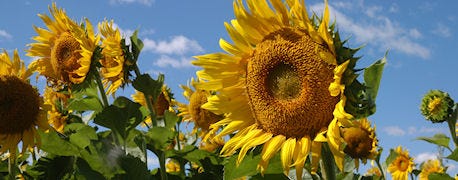May 21, 2013

Producers who have winter wheat acres that are in dire straits may want to consider sunflower if their wheat crop is "zeroed out," says John Sandbakken, executive director of the National Sunflower Association.
The USDA Risk Management Agency will allow a second crop to be planted and insured on failed acres. Producers who choose to plant a second crop would receive 35% of their indemnity payment with the remaining 65% withheld until the sunflowers are harvested.

Sunflowers might be just the ticket for failed winter wheat acres. They can be as a second crop and you can insure them.
If a loss occurs with the sunflowers; the producer is eligible to choose between taking the remaining indemnity payment for the wheat loss or take the indemnity for the sunflower loss. Contact your local insurance agent to check out this option, Sandbakken says.
If you plant sunflower, consider these tips to get the best results
Slow down. Speed is often the cause of skips and doubles, especially with plate and finger type planters.
Use a lubricant with treated seed if your planter manual recommends it. The manual will specify wither the lubricant should be graphite or talc. They are not interchangeable. Generally, talc is used in vacuum and air planters, and graphite in finger pick-up planters.
Recalibrate every time you switch to planting a different variety, and even different seed lots of the same variety.
Plant at a depth of 1.5 to 2.5". If you're planting at the furthest end of that range or deeper, consider planting a smaller seed size and increasing the planted population.
Plant about 10-15% above the desired final population and go with a lower rate if using treated seed.
Check to make sure you're knifing into the soil. Hair pinning – pushing chaff or straw into the seed slot instead of slicing through it – tends to be more a problem with air drills, particularly when seeding into no-till. Hair pinning is more of a problem when residue is wet – resolving the issue may be a matter of waiting until standing stubble becomes dry, and slicing through becomes easy. In other cases, you may need to sharpen drill discs/blades, or adjust down pressure.
Fill the seed boxes, plant a short distance, then stop and check seeding depth, down pressure, seed-to-soil contact, uniformity in seeding depth and seed spacing, and furrow closure.
When planting sunflower late (generally after June 10 in the Northern Plains) or replanting, use an early-maturing hybrid. The fact that sunflower performs well at lower populations suggests that replant is an option that might be best left for extreme early stand losses, especially in the shorter growing season of the Northern Plains. Some agronomists advise replanting only if a stand falls below a threshold of about 12,000 to 15,000 plants, or more than 25% of your yield goal. Otherwise, you'd be losing two weeks of crop maturity, and the successful establishment of the replanted crop isn't a guarantee either.
Source: National Sunflower Association
You May Also Like




